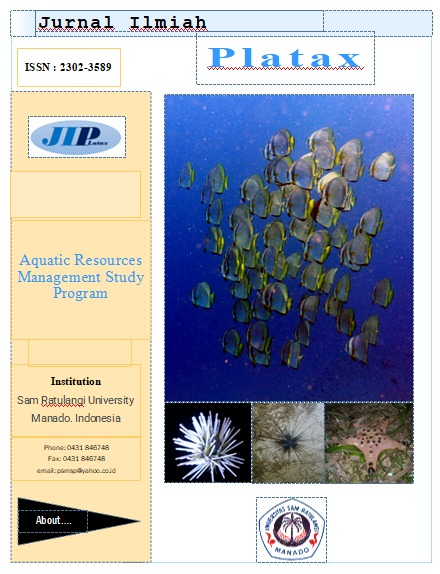Institutional Domain Assessment of the EAFM Approach to Snapper and Grouper Fisheries in the waters of the Sangihe Islands, North Sulawesi
DOI:
https://doi.org/10.35800/jip.v12i1.52237Keywords:
EAFM, Sangihe Islands, Grouper Snapper Fishery, Flag ModelAbstract
This research aims to assess the status of snapper and grouper fisheries management in the Sangihe Islands district using an ecosystem approach (EAFM) in the institutional domain. The research method uses observation and interview methods (questionnaires). Data collection used semi-structured interview (SSI) techniques. As a result of the assessment of 6 (six) institutional indicators, there are 2 indicators with a value of 1 (less, red flag model), namely indicators of compliance with the principles of responsible fisheries and indicators of fisheries management plans. 3 indicators each: decision-making mechanism indicators, indicators of the level of synergy of fisheries management policies & institutions, and stakeholder capacity indicators) with a value of 2 (medium, yellow model flag). Only the indicator for the completeness of the rules in fisheries management has a value of 3 (good, green model flag). The average score for the 6 indicators is 1.76 while the composite value is 58.53. This value shows that the application of the EAFM institutional domain in the management of snapper and grouper fisheries in the Sangihe Islands district is in the medium category (yellow model flag).
Keywords: EAFM, Sangihe Islands, Grouper Snapper Fishery, Flag Model.
Abstrak
Penelitian ini bertujuan untuk menilai status pengelolaan perikanan kakap dan kerapu di kabupaten Kepulauan Sangihe dengan pendekatan ekosistem (EAFM) pada domain kelembagaan. Metode penelitian menggunakan metode observasi dan wawancara (kuisioner). Pengumpulan data menggunakan teknik semi structured interview (SSI). Hasil penilaian dari 6 (enam) indikator kelembagaan, ada 2 indikator yang nilai-nya 1 (kurang, flag model merah) yaitu indikator kepatuhan terhadap prinsip-prinsip perikanan yang bertanggung jawab dan indikator rencana pengelolaan perikanan. 3 indikator masing-masing : indikator mekanisme pengambilan keputusan, indikator tingkat sinergisitas kebijakan & kelembagaan pengelolaan perikanan, indikator kapasitas pemangku kepentingan) bernilai 2 (sedang, flag model kuning). Hanya indikator kelengkapan aturan main dalam pengelolaan perikanan yang bernilai 3 (baik, flag model hijau). Nilai skor rerata 6 indikator adalah 1,76 sedangkan nilai komposit-nya 58,53. Nilai ini menunjukkan bahwa penerapan domain kelembagaan EAFM pada pengelolaan perikanan kakap dan kerapu di kabupaten Kepulauan Sangihe kategori sedang (flag model kuning).
Kata kunci : EAFM, Kepulauan Sangihe, Perikanan Kerapu Kakap, Model Bendera
References
Budiarto, A., Adrianto, L., & Kamal, M. (2015). Status pengelolaan perikanan rajungan (Portunus pelagicus) dengan pendekatan ekosistem di Laut Jawa (WPPNRI 712). Jurnal Kebijakan Perikanan Indonesia, 7(1), 9-24.
Charles AT. 2008. Sustainable fishery systems. John Wiley & Sons.
Dwihastuty, L., Arkham, M. N., Digdo, A. A., & Putriraya, A. R. (2023). Pengelolaan Perikanan Gurita dengan Pendekatan Pengelolaan Perikanan Berbasis Ekosistem (EAFM) di Kabupaten Minahasa Utara, Provinsi Sulawesi Utara. Buletin Ilmiah Marina Sosial Ekonomi Kelautan dan Perikanan, 9(2), 179-194.
Fisheries, U. N. (2003). Fisheries Management. 2: The Ecosystem Approach to Fisheries. FAO Fisheries Technical Guidelines for Responsible Fisheries.
[KKP] Kementerian Kelautan dan Perikanan. 2014. Peraturan Menteri Kelautan dan Perikanan Republik Indonesia Nomor 18 tahun 2014 tentang Wilayah Pengelolaan Perikanan Negara Republik Indonesia. Jakarta (ID): KKP.
Lasabuda, R. (2013). Pembangunan wilayah pesisir dan lautan dalam perspektif Negara Kepulauan Republik Indonesia. Jurnal ilmiah platax, 1(2), 92-101.
Miller, C. A., & Wyborn, C. (2020). Co-production in global sustainability: Histories and theories. Environmental Science & Policy, 113, 88-95.
Muawanah, U., Yusuf, G., Adrianto, L., Kalther, J., Pomeroy, R., Abdullah, H., & Ruchimat, T. (2018). Review of national laws and regulations in Indonesia with an ecosystem approach to fisheries management. Marine Policy, 91, 150-160.
EAFM, N. (2014). Modul penilaian indikator untuk perikanan dengan pendekatan ekosistem. National Working Group on Ecosystem Approach to Fisheries Management. Direktorat Sumber Daya Ikan. Kementerian Kelautan Perikanan Republik Indonesia.
Ostrom, E. (1985, May). Formulating the elements of institutional analysis. In a Conference on Institutional Analysis and Development Washington DC May (pp. 21-22).
Riduwan. (2004). Metode Riset. Penerbit: Rineka Cipta. Jakarta.
regiwati, L.A., Wiryawan, B., Baskoro, M.S., Wisudo, S.H., & Satria, A. (2015). Linking indicators for ecosystem approach fisheries management and management of marine protected area effectiveness in Anambas Island, Indonesia. Aquaculture, Aquarium, Conservation & Legislation International Journal of the Bioflux Society. Vol 8 (No. 6), 1048-1063, http://www.bioflux.com.ro/docs/2015.1048- 1063.pdf
Sadovy de Mitcheson, Y., Craig, M. T., Bertoncini, A. A., Carpenter, K. E., Cheung, W. W., Choat, J. H., ... & Sanciangco, J. (2013). Fishing groupers towards extinction: a global assessment of threats and extinction risks in a billion dollar fishery. Fish and Fisheries, 14(2), 119-136.
Downloads
Published
How to Cite
Issue
Section
License
Copyright (c) 2024 Davis Wijaksana Extrada dumas, Ridwan Lasabuda, Indri Shelovita Manembu, Daisy M. Makapedua, Suria Darwasito, Alfrets Luasunaung, Deiske Adeliene Sumilat, Oktaviano P. Darmono

This work is licensed under a Creative Commons Attribution-NonCommercial 4.0 International License.
COPYRIGHT
Authors who publish with this journal agree to the following terms:
Authors hold their copyright and grant this journal the privilege of first publication, with the work simultaneously licensed under a Creative Commons Attribution License that permits others to impart the work with an acknowledgment of the work's origin and initial publication by this journal.
Authors can enter into separate or additional contractual arrangements for the non-exclusive distribution of the journal's published version of the work (for example, post it to an institutional repository or publish it in a book), with an acknowledgment of its underlying publication in this journal.
Authors are permitted and encouraged to post their work online (for example, in institutional repositories or on their website) as it can lead to productive exchanges, as well as earlier and greater citation of the published work (See The Effect of Open Access).




















